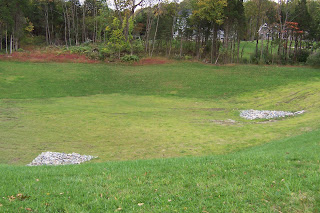Native Plant for Fall Color
American Spikenard (Aralia racemosa) is an easy-to-grow native plant that sports colorful berries beginning in late summer and continuing into fall. The berries, beloved by birds, start out a light green, progress to a pinkish tone, and when mature, are deep purple. All three colors can appear simultaneously on the large panicles.
This month, the Garden Bloggers’ Design Workshop over at Gardening Gone Wild (http://www.gardeninggonewild.com/?p=7602#more-7602) features The Garden in Fall and the variety of ways to introduce fall color – flowers, foliage, and fruit.
After only three years, my plant is about four feet tall and five feet wide. It had a huge growth spurt this year, no doubt triggered by our ceaseless rain. It might have gotten taller, but the central leader was cut clean through by stem borer, something I’ve never experienced before. The plant, in fact has outgrown its space (I had understood it would grow to only three to four feet in each direction), and will have to be moved slightly forward of its present location.
Earlier in the summer, the racemes are covered by thousands of puffy whitish green flowers. The flowers and leaves contrast nicely with the wine-colored stems, which are thick and sturdy, but not woody. Come winter, the whole plant dies back to the ground, so I have to hunt around for it the following spring.
American Spikenard is an attractive, showy native that fits into any style garden, but is especially useful in the woodland garden, where it blends in nicely with neighboring trees and shrubs.
This month, the Garden Bloggers’ Design Workshop over at Gardening Gone Wild (http://www.gardeninggonewild.com/?p=7602#more-7602) features The Garden in Fall and the variety of ways to introduce fall color – flowers, foliage, and fruit.
After only three years, my plant is about four feet tall and five feet wide. It had a huge growth spurt this year, no doubt triggered by our ceaseless rain. It might have gotten taller, but the central leader was cut clean through by stem borer, something I’ve never experienced before. The plant, in fact has outgrown its space (I had understood it would grow to only three to four feet in each direction), and will have to be moved slightly forward of its present location.
Earlier in the summer, the racemes are covered by thousands of puffy whitish green flowers. The flowers and leaves contrast nicely with the wine-colored stems, which are thick and sturdy, but not woody. Come winter, the whole plant dies back to the ground, so I have to hunt around for it the following spring.
American Spikenard is an attractive, showy native that fits into any style garden, but is especially useful in the woodland garden, where it blends in nicely with neighboring trees and shrubs.



